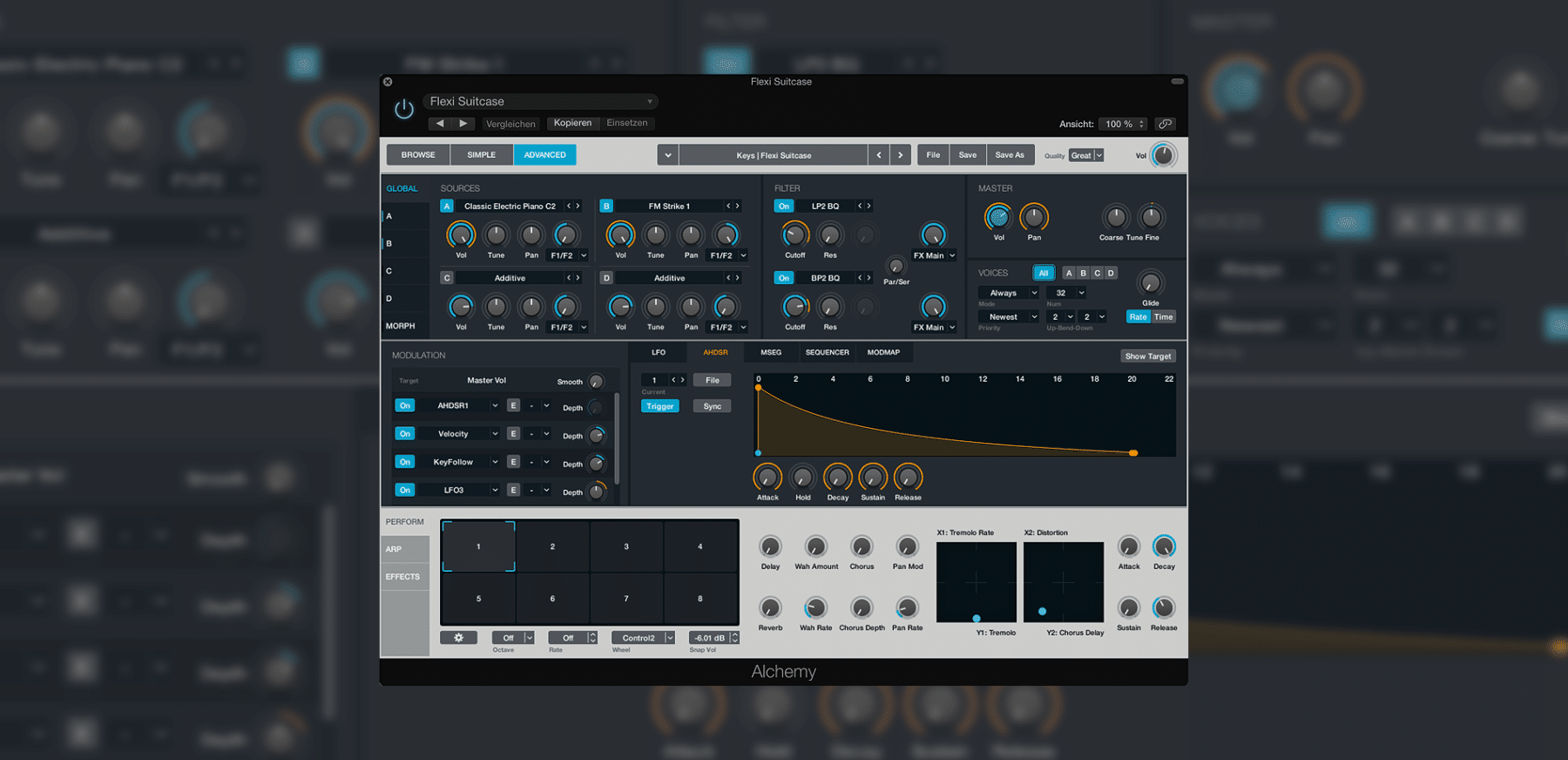
Alchemy For Logic Pro X
January 8, 2015 was a sad day for all of us in the softsynth community, marking the death of Camel Audio, perhaps one of the most ambitious and beloved developers in the business. I could speculate or even draw on several ongoing rumors surrounding the unexpected demise of a software monolith, but I‘m more interested in what the future holds, and I’m very certain that the brightest sparks among Camel Audio will continue to improve upon the source code for their flagship power synth Alchemy, regardless of what it says on the tin.
While Windows users might not usher in the return of Alchemy with as much enthusiasm as Apple Logic Pro X users, the mere fact that Alchemy survived the landfall is call for celebration. But what’s really exciting is that this is now the official version 2.0, which Alchemy purists have been eagerly anticipating for almost four years. Yeah, now it’s a party.
The Rundown
For those unfamiliar with Alchemy, this is a powerful hybrid synth unlike any other. It offers six synthesis engines: spectral, additive, granular, resynthesis, sampler and virtual analog. Also, there are all new filters, including refurbished resonant filters for physical modelling purposes. If you can think of it, Alchemy can do it, plus several other things you probably haven’t thought of.
The GUI has undergone a much needed facelift, which is a considerable improvement upon less attractive predecessors. Alchemy has three tabs in the top-left corner of the user interface labeled “Browse”, “Simple” and “Advanced”. The Browse view has organized the preset library within several metadata columns specific to Category, Subcategory, Genre, Timbre, Ratings, Attributes and a preset display window with a User Tags editor and a capable search engine.
The Simple view is similar to the old free Player version, which is obviously no longer available, offering the same sixteen performance controls located within the Perform/Arp/Effects section of the Advanced view. These controls include two XY pads, eight assignable knobs and an ADSR envelope. Also, there’s a Transform Pad that lets you morph between any one of eight available snapshots of performance control settings, allowing for some wonderfully complex sounds.
In the Advanced view, there are up to four Sources (A/B/C/D) for each preset. Each of these sources employ multiple synthesis types that you can either use independently or in tandem. However, it’s not possible to combine every synthesis type within a single source, which is why combinable synthesis types are highlighted with a blue indicator in the Source Subpage. Also, the Global button will display Source Master Controls, and the Morph button will display controls that enable you to morph between each of the four sources in real time.
But the rabbit hole goes deeper. Much deeper. Each of the four Source Subpages include an Import Browser available in the Granular, Additive, Spectral and Sampler engines supporting WAV, AIFF and EXS sound files, and an Edit button next to the Source Select Field that will open the Source Edit window featuring Additive and Spectral Editors intended for manipulating resynthesis data, whether it be harmonic partials or frequency spectra.
There are two multimode filters that you can either route in parallel or in series, and you can also blend the two configurations (or more specifically, the input signal) with the “Par/Ser” knob. Each of these two filters offer a vast assortment of filter types. Obviously, you have a generous supply of traditional lowpass, bandpass and highpass filters, but there are also less common types such as Ring Modulation, Frequency Modulation, Distortion, Formant, Peak and three Comb filter algorithms with positive, negative or bipolar feedback.
In the Effects Section, there are five independent effects racks (Main/A-D) with over a dozen assignable effects modules split up into four basic categories: Dynamic/Utility, Filter, Modulation and Reverb. On/Off buttons are made available for each individual effect rack, and there are also quite a few commands in the File pop-up menu, which includes a very useful option to Randomize settings in any one of the selected effects modules.
Alchemy’s Arpeggiator offers a handsome variety of controls, with five source buttons (All/A-D) that allow you to specify the target source, and a Sequencer Window similar to the Sequencer in the Modulation Section that I’ll cover in a bit. But before I get ahead of myself, I’d like to go over the basic arpeggiator controls in more detail. When set to “All”, the arpeggiator pattern is played by all or any currently active source, and (obviously) buttons A-D will assign the pattern to the corresponding source. In the top-right corner of the basic arpeggiator controls section, there’s a button that will Sync the arpeggiator to the current project tempo, and a second button that will Trigger the pattern with the first played note, which is perfect for gated chords. I could amass a compendium of features, but there’s simply too much here for the purposes of this article.
In the Modulation Section, ten modulation slots are available underneath the Target Field within the modulation rack controls wherein you can map almost any parameter you can think of to as many as sixteen LFOs, AHDSR and MSEG Segment Envelopes, a powerful Step Sequencer, Mod Mapper, Envelope Follower, Note Property and Performance Control Modulators.[/vc_column_text][vc_column_text]
The Lowdown
Now for that part of the review where I’m supposed to say something like “I wish I could do this” or “I’d like to see more of that”, but I honestly can’t think of a single aspect of Alchemy that falls short of awesome without splitting hairs over some painfully superfluous detail. Windows users might feel a bit jilted, especially those who purchased Alchemy not long ago, but I can’t help but see this merger as a win for Apple and for Camel Audio.
The fact that Alchemy now ships with Logic Pro X will likely stir up a renewed interest in this already popular DAW, with (albeit very well designed) factory plugins that pale in comparison to something as extraordinarily powerful as Alchemy. This is arguably the holy grail of softsynths, a truly inspiring sound design tool, and also one of the most flexible “romplers” money can buy, which helps to make Logic Pro X worth every penny.


One Comment
Hip Hop Instrumentals: 7 Tips for Buying Beats Online
[…] you find a a beat you like, you might be tempted to buy it wherever you found it. But hold up! Beats can be purchased and […]